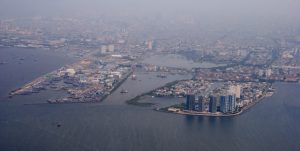Environmental problems in a megacity
Not long ago I was passing through Jakarta, the capital of the fourth most populous country in the world – Indonesia. In the late afternoon I was in Kota Tua, the oldest part of the city, when it started raining. No mild Icelandic spring rain this, but a real tropical downpour. I sought shelter under a tarp strung up by some street food vendors. The streets quickly turned to rivers. But the food stall owners continued without any hiccups and kept on serving their customers sate kambing and nasi goreng. I had my dinner and chatted with the people while I waited for the rain to cease. And started thinking about the environment that the inhabitants fo rapidly growing megacities, especially Jakarta, must live with on a day-to-day basis.
Cities are an ancient form of settlement. Even so, it is only a few years since cities became the home of the majority of mankind. Urban-rural migration, which started in Europe during the 18th century industrial revolution , has continued. In the poorer parts of the world this process is particularly prominent now. People have continued looking for a better life in cities, many of which have already became huge - and are still growing. The forecast is that until the year 2050 the number of city dwellers will grow by no less than 2.5 billions.
Many of the world's largest cities are in Asia. Among them is Jakarta, together with its peripheral cities that form a contigous urban area. The urban expanse that is Greater Jakarta (or „Jabodetabek“, as the area is officially called – Jakarta, Bogor, Depok, Tangerang and Bekasi) is now home to more than thirty million people and covers nearly 6.400 km2. The urban fabic is most dense in Jakarta itself. There some ten million people live in a space of 660 km2, which translates into at least 15,000 inhabitants per square kilometer on average.
The city is located on an alluvial plain in the western half of Java's north coast. Most of this plain is only a few meters above sea level. It was the Dutch who by founded the port of Batavia there during colonial times, but a lot of water has passed under the city's bridges since and the city centre is now located a few kilometers to the south. Beyond the plain, hills and mountains dot the landscape, including Gunung Gede, an almost 3000 m high volcanic cone.
It goes without saying that environmental issues are prominent in a megacity such as this one. The people of Jakarta have to tackle similar issues as those living in other cities, but its location and natural circumstances create special challenges. In addition, the planning of the city – eða perhaps the lack of it – has not alleviated the problems.
Flooding is an annual event in the city. The rainy season in this monsoon climate is at its peak at the beginning of the year – in January and February it rains about 300 mm each month on average, often in torrential bursts. Some thirteen rivers run through the city from the hills around it. In these hills, the forest has been decimated and the ability of the land surface to regulate the flow of water has therefore been severely diminished. The urbanization has then of course made the hydrologic system less effective. Instead of lakes and wetlands, that received excess water before, have come industrial areas, settlements and streets - inpermeable surfaces. In most cases the urban development goes all the way down to the riverbanks. A lot of trash has also collected in the rivercourses, obstructing the flow of water. Down in the city, the water leaves the river courses, sometimes submerging large swathes of the city during the rainy season.
Another threat to Jakarta, also caused by humans, is subsidence. Much of the city area has gradually subsided during the past decades. The reason is in part simply the weight of urban structures, not least the numerous and extremely heavy skyscrapers that have proliferated. But the main cause is the relentless pumping of groundwater from aquifers under the city, which meets most of its water needs. This subsidence is no small matter. In some places the land surface is more than one metre lower then it used to be, and is still sinking at a rate from three to ten centimetres per year, even more. One does not need

Coastal parts of Jakarta.
much imagination to understand that this has made the coastal areas in the north of the city very vulnerable to intrusions of the sea – a large part of the city area is in fact already under sea level. But the subsidence also harms vital infrastructure, such as water and sewage. The damage has been done and cannot be reversed. The sinking could be slowed down by stopping the pumping of frsh water from the ground, but huge new infrastructure would be needed for providing the city with water. This is not in sight.
The same applies to Jakarta as to many other parts of the world, where environmental problems have become serious: those who can least afford it are most affected. Those who are economically better off move to the suburbs, where the density of settlement is lower, or congregate in tall residential condominiums, from where they can look down upon the watery world below and those who have to live with and in it. It is the poor who suffer. They have made their homes in places that richer people avoid, often in no-mans-land. The slums of Jakarta are gigantic. Small sheds and shelters can be seen on riverbanks, under motorways, along railway lines and down at the waterfront. Unfortunately, much of the effort by city authorities to prevent further damage from flooding has consisted of sending bulldozers in to clear such areas, in order to build ever larger structures for protection. Poor people have been involuntarily resettled in large numbers to faraway parts of the city.
The city is a wonderful form of settlement – but when cities start growing too fast, many things can go astray. The environmental problems of rapidly growing megacities, such as Jakarta, are among the biggest challenges of our times. Looking at predictions about growth in the number of city dwellers until 2050, there will be plenty of things to do in this field in the coming years. Many of the problems of this particular city could have been solved by careful planning - in time. Unfortunately this has not been the case here. Those dealing with environment and urban planning also need to show some understanding and empathy with the urban populations, which need to be consulted. This also seems to have been lacking here. But I nevertheless hope that those working in the urban planning establishment of Jakarta occasionally venture out to the slums, to listen to what those who live there have to say. And while there, they could grab something delicious to eat.
(First published 9 April 2017 at Umhverfisfréttir)

